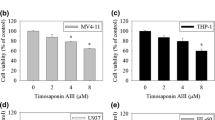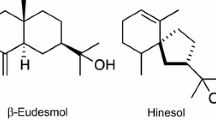Abstract
Mangiferin, 1,3,6,7-tetrahydroxyxanthone-C2-β-d-glucoside (C-glucosylxanthone), is a xanthone derivative that is widely distributed in higher plants. Recently, mangiferin was found to exhibit potential antitumor effects. However, the molecular mechanisms of this effect have not been elucidated. In the present study, we attempt to clarify the mechanism of mangiferin-induced apoptosis in the human acute myeloid leukemia cell line HL-60; mangiferin was found to induce apoptosis. We also observed a concurrent increase in caspase-3 activity and DNA fragmentation. Furthermore, on examining the survival signals expressed during apoptotic induction, we observed that mangiferin caused a remarkable decrease in the nuclear entry of NF-κB p65. However, there were no changes in the expression of other survival signals, such as extracellular signal-regulated kinase 1/2, protein kinase B, and p38 mitogenactivated protein kinase. In addition, mangiferin suppressed the expressions of Bcl-xL and XIAP; however, we did not note any changes in the levels of Bcl-2, Bax, and Bim. These results indicate that mangiferin induces apoptosis by suppressing NF-κB activation and expressions of Bcl-xL and XAIP. These findings suggest that mangiferin may be useful as an anticancer agent and can be used in combination therapy with other anticancer drugs for the treatment of acute myeloid leukemia.
Similar content being viewed by others
References
Aribi, A., Ravandi, F., and Giles, F., Novel agents in acute myeloid leukemia. Cancer J., 12, 77–91 (2006).
Bueso-Ramos, C. E., Rocha, F. C., Shishodia, S., Medeiros, L. J., Kantarjian, H. M., Vadhan-Raj, S., Estrov, Z., Smith, T. L., Nguyen, M. H., and Aggarwal, B. B., Expression of constitutively active nuclear-kappa B RelA transcription factor in blasts of acute myeloid leukemia. Hum. Pathol., 35, 246–253 (2004).
Frelin, C., Imbert, V., Griessinger, E., Peyron, A. C., Rochet, N., Philip, P., Dageville, C., Sirvent, A., Hummelsberger, M., Bérard, E., Dreano, M., Sirvent, N., and Peyron, J. F., Targeting NF-kappaB activation via pharmacologic inhibition of IKK2-induced apoptosis of human acute myeloid leukemia cells. Blood, 105, 804–811 (2005).
Ghosh, S., May, M. J., and Kopp, E. B., NF-κB and Rel proteins: evolutionarily conserved mediators of immune responses. Annu. Rev. Immunol., 16, 225–260 (1998).
Glimore, T. D., Introduction: the Rel/NF-κB signal transduction pathway. Semin. Cancer Biol., 8, 61–62 (1997).
Glimore, T. D., Multiple mutations contribute to the oncogenicity of the retroviral oncoprotein v-Rel. Oncogene, 18, 6925–6937 (1999).
Green, D. R. and Evan, G. I., A matter of life and death. Cancer Cell, 1, 19–30 (2002).
Grimwade, D., Walker, H., Harrison, G., Oliver, F., Chatter, S., Harrison, C. J., Wheatley, K., Burnett, A. K., and Goldstone, A. H., Medical Research Council Adult Leukemia Working Party, The predictive value of hierarchical cytogenetic classification in older adults with acute myeloid leukemia (AML): analysis of 1065 patients entered into the United Kingdom Medical Research Council AML11 trial. Blood, 98, 1312–1320 (2001).
Guzman, M. L., Neering, S. J., Upchurch, D., Grimes, B., Howard, D. S., Rizzieri, D. A., Luger, S. M., and Jordan, C. T., Nuclear factor-kappaB is constitutively activated in primitive human acute myelogenous leukaemia cells. Blood, 98, 2301–2307 (2001).
Harris, M. H. and Thompson, C. B., The role of the Bcl-2 family in the regulation of outer mitochondrial membrane permeability. Cell Death Differ., 7, 1182–1191 (2000).
Jeong, S. Y. and Seol, D. W., The role of mitochondria in apoptosis. BMB Rep., 41, 11–22 (2008).
Jin, X., Lin, Q., Zhang, D., Zhang, M., Wang, Z., Guo, Z., Peng, M., Deng, C., and Guo, C., Chemosensitization in non-small cell lung cancer cells by IKK inhibitor occurs via NF-κB and mitochondrial cytochrome c cascade. J. Cell. Mol. Med., 13, 4596–4607 (2009).
Karin, M. and Lin, A., NF-κB at the crossroads of life and death. Nat. Immunol., 3, 221–227 (2002).
Kelekar, A. and Thompson, C. B., Bcl-2-family protein: the role of the BH3 domain in apoptosis. Trends Cell Biol., 8, 324–330 (1998).
Kimby, H., Nygren, P., and Glimelius, B., A systematic overview of chemotherapy effects in acute myeloid leukemia. Acta Oncol., 40, 231–252 (2001).
Matsuda, H., Tokunaga, M., Iwahashi, H., Naruto, S., Yagi, H., Masuko, T., and Kubo, M., Studies on Plauan Medical Herbs. II. Activation of mouse macrophages RAW264.7 by ongael, leaves of Phaleria cumingii (MEISN.) F. VILL. and its acylglucosylsterols. Biol. Pharm. Bull., 28, 929–933 (2005a).
Matsuda, H., Tokunaga, M., Iwahashi, H., Naruto, S., Yagi, H., Masuko, T., and Kubo, M., Studies on Plauan Medical Herbs. III. Antitumor and immunostimulatory activities of Ongel, leaves of Phaleria cumingii (MEISN.) F. VILL. J. Trad. Med., 22, 314–320 (2005b).
Ravi, R. and Bedi, A., NF-κB in cancer-a friend turned foe. Drug Resist. Updat., 7, 53–67 (2004).
Sethi, G., Ahn, K. S., and Aggarwal, B. B., Targeting nuclear factor-kappa B activation pathway by thymoquinone: role in suppression of antiapoptotic gene products and enhancement of apoptosis. Mol. Cancer Res., 6, 1059–1070 (2008).
Zamzami, N., Marchetti, P., Castedo, M., Zanin, C., Vayssiere, J. L., Petit, P. X., and Kroemer, G., Reduction in mitochondrial potential constitutes an early irreversible step of programmed lymphocyte death in vivo. J. Exp. Med., 181, 1661–1672 (1995).
Author information
Authors and Affiliations
Corresponding author
Additional information
These authors contributed equally to this work.
Rights and permissions
About this article
Cite this article
Shoji, K., Tsubaki, M., Yamazoe, Y. et al. Mangiferin induces apoptosis by suppressing Bcl-xL and XIAP expressions and nuclear entry of NF-κB in HL-60 cells. Arch. Pharm. Res. 34, 469–475 (2011). https://doi.org/10.1007/s12272-011-0316-8
Received:
Revised:
Accepted:
Published:
Issue Date:
DOI: https://doi.org/10.1007/s12272-011-0316-8




